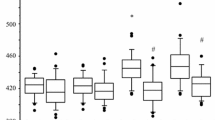Abstract
Sevoflurane is shown to be safe and effective in pediatric echocardiography. This study explores the optimum level in pediatric echocardiography. One hundred and twenty children, with an age range of 35 days–3 years, were included in this study. The children with severe cyanotic congenital heart disease or severe pneumonia, which was Grade I or II according to the American College of Physicians Guideline Grading, were excluded. All children received the anesthesia with sevoflurane. The inhalation anesthesia level decreased from 2.5 to 1.0 %, with a decrement of 0.5 %. The induction time (T0), echocardiography time (T1), and time to awakening (T2) in each child were recorded, and the changes in the blood pressure, heart rate, breath, and oxygen saturation in each child were also monitored. The Ramsay scale scoring during anesthesia and the case number of failure in echocardiography in each group were also recorded. When the level of sevoflurane inhalation was maintained at 1.0 %, the childrens’ scores were low, including 8 incompliant children, and p < 0.05 in comparison with other groups. The scores increased as the sevoflurane inhalation level increased. When the sevoflurane inhalation increased to 1.5 %, the children could sleep with stable blood pressure, and no dysphoria occurred during the echocardiography. When the sevoflurane inhalation level increased to 2.5 %, the Ramsay scores did not increase. However, the T2 significantly increased (p < 0.05). The blood pressure and heart rate in each group did not change significantly. With the premise of safety and efficacy in children, the optimum level of sevoflurane in pediatric echocardiography was 1.5–2.0 %.
Similar content being viewed by others
References
Dai, T., & Yu, T. (2011). Anesthetic Pharmacology (3rd ed., pp. 58–74). Beijing: People’s Medical Publishing House.
Li, S., Zhi, W., & Zhu, Z. (2005). The efficacy of midazolam combined with chloral hydrate in the sedation before pediatric CT. International Medicine & Health Reports, 10, 85–86.
Oto, J., Yamamoto, K., Koike, S., et al. (2011). Effect of daily sedative interruption on sleep stages of mechanically ventilated patients receiving midazolam by infusion. Anaesthesia and Intensive Care, 39, 392–400.
Ozdemir, K. I., Egilmez, H., Kaygusuz, K., Gursoy, S., & Mimaroglu, C. (2008). Open-label, prospective, randomized comparison of propofol and sevoflurane for laryngeal mask anesthesia for magnetic resonance imaging in pediatric patients. Clinical Therapeutics, 30, 175–181.
Toscano, A., Pancaro, S., Giovannoni, G., Minelli, G., Baldi, C., Guerrieri, G., et al. (2003). Sevoflurane analgesia in obstetrics: A pilot study. International Journal of Obstetric Anesthesia, 12, 79–82.
Xia, B., Liu, K., Wang, C., et al. (2010). The efficacy of oral midazolam in the pediatric dentistry. Peking University Proceedings (Medicine), 42(1), 78–81.
Yang, W., & Huang, W. (2006). The applications of sevoflurane in adult ambulatory surgery. Journal of Clinical Anesthesiology, 22, 239–240.
Funding
This study was funded by 9th High level talent Project of Jiangsu “Summit of 6 Talents” (Project No. 2012-WS-010), under Xuzhou Science and Technology Project.
Author information
Authors and Affiliations
Corresponding author
Rights and permissions
About this article
Cite this article
Conghai, F., Fengchao, Z., Chengjing, S. et al. The Optimum Level of Sevoflurane in Pediatric Echocardiography. Cell Biochem Biophys 73, 345–347 (2015). https://doi.org/10.1007/s12013-015-0602-z
Published:
Issue Date:
DOI: https://doi.org/10.1007/s12013-015-0602-z




